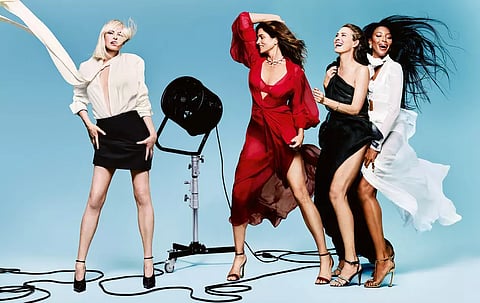

Well, hello there,Linda, Christy, Naomi and Cindy, the O.G. supermodels; women for whom the term was created; creatures who became so famous that they didn’t even need last names, like Aretha or Marilyn. Back, once again, on the cover of the September issue of Vogue, that vestigial megalith from the magazine era, decades after you emerged. We’ve clearly missed you.
Yet beneath the chorus of love is another, growing strain of commentary that is slightly less enthralled. One focused on calling out what many viewers see as egregious age erasing: the promotion of women age 58 (Linda Evangelista), 57 (Cindy Crawford), 54 (Christy Turlington) and 53 (Naomi Campbell) as paragons of mature beauty whose years have seemingly been smoothed from their faces. Who look so retouched that they seem more like AI-generated bots than actual people. According to a Vogue spokeswoman, there was only “minimal retouching and minimal lighting” on the photographs. But in a world where we are increasingly concerned about the blurred line between virtual reality and actual reality, where disinformation is rife, the definition of “minimal” and what exactly that means is a relative issue.
It casts an uneasy light over the whole shoot — how much of it is real, how much Photoshop — that doesn’t serve anyone involved. It doesn’t serve the women on the cover, who broke through back in the day because they had character and were willing to show it; because they didn’t want to be blank mannequins, as models had generally been before them, but individuals with personalities and attitudes and opinions of their own. The kind of personalities that involve expressions, which over time etch years and experiences — joy, sorrow, laughter, fury — onto the topography of a face. And it doesn’t serve the women who look to them as role models.
It is positive that Vogue, a brand that still positions itself as the bible of fashion, even as its hold on that position seems increasingly tenuous, is putting women in the fullness of their life on its biggest cover of the year. Certainly, images of models at every age are retouched (sometimes ridiculously so). When looking at photos of teenagers and 20-somethings, it is possible to delude yourself into accepting the impossibly flawless nature of what you see. Thirty years later, it’s harder to pretend.
Which means it’s hard not to think that here was a lost opportunity to embrace all of the hallmarks of our humanity, not to mention transparency about what we are faking (or not). Fixing a wrinkle here, some crow’s-feet there, may seem like a little thing. But it’s part of what chips away at our shared sense of truth. After all, if anyone should understand the complexities of female aging in a society obsessed with youth, it is the women who represented the pinnacle of that youthful beauty.
It’s particularly ironic, coming just after the death of Jane Birkin, and the celebrations of her life and style, which were marked by a thrilling disregard for the pressure to play by any rules and a willingness to embrace her own wrinkles and the stories they told. So let them be visible, marks and all. They once were pioneers of a new kind of beauty. Here’s hoping they will be again.